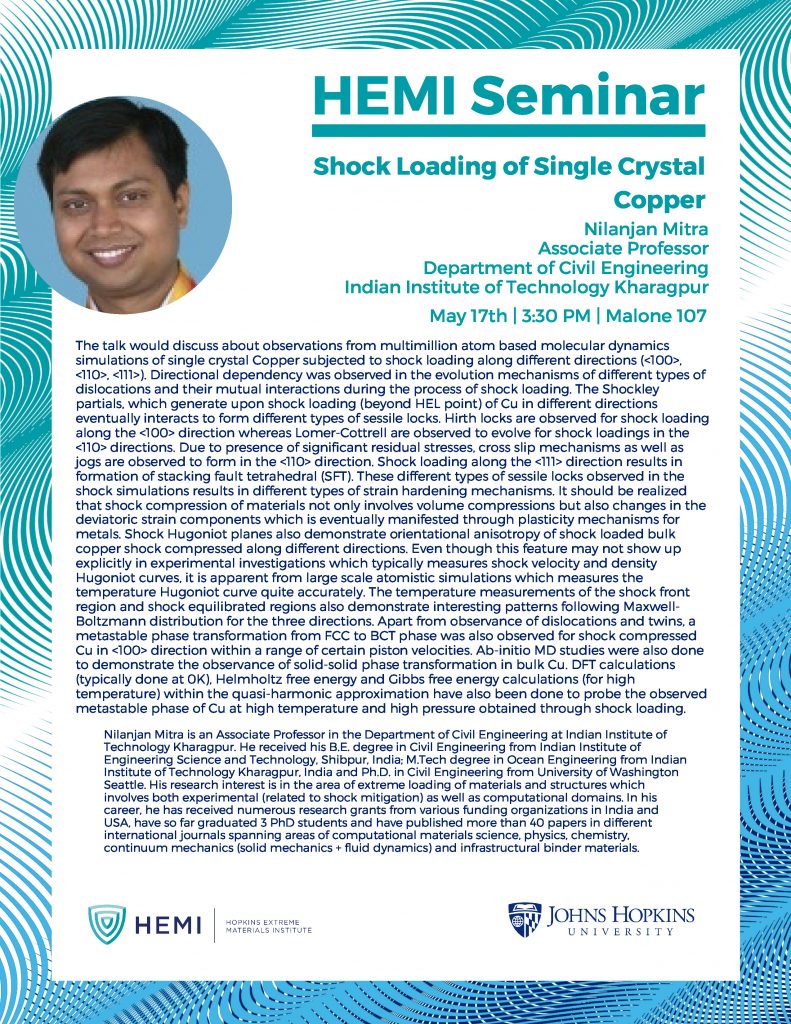May 17, 2019 @ 3:30 pm - 4:30 pm
Event Navigation
Shock Loading of Single Crystal Copper
Nilanjan Mitra
Associate Professor, Dept. of Civil Engineering
Indian Institute of Technology Kharagpur
The talk would discuss about observations from multimillion atom based molecular dynamics simulations of single crystal Copper subjected to shock loading along different directions (<100>, <110>, <111>). Directional dependency was observed in the evolution mechanisms of different types of dislocations and their mutual interactions during the process of shock loading. The Shockley partials, which generate upon shock loading (beyond HEL point) of Cu in different directions eventually interacts to form different types of sessile locks. Hirth locks are observed for shock loading along the <100> direction whereas Lomer-Cottrell are observed to evolve for shock loadings in the <110> directions. Due to presence of significant residual stresses, cross slip mechanisms as well as jogs are observed to form in the <110> direction. Shock loading along the <111> direction results in formation of stacking fault tetrahedral (SFT). These different types of sessile locks observed in the shock simulations results in different types of strain hardening mechanisms. It should be realized that shock compression of materials not only involves volume compressions but also changes in the deviatoric strain components which is eventually manifested through plasticity mechanisms for metals. Shock Hugoniot planes also demonstrate orientational anisotropy of shock loaded bulk copper shock compressed along different directions. Even though this feature may not show up explicitly in experimental investigations which typically measures shock velocity and density Hugoniot curves, it is apparent from large scale atomistic simulations which measures the temperature Hugoniot curve quite accurately. The temperature measurements of the shock front region and shock equilibrated regions also demonstrate interesting patterns following Maxwell-Boltzmann distribution for the three directions. Apart from observance of dislocations and twins, a metastable phase transformation from FCC to BCT phase was also observed for shock compressed Cu in <100> direction within a range of certain piston velocities. Ab-initio MD studies were also done to demonstrate the observance of solid-solid phase transformation in bulk Cu. DFT calculations (typically done at 0K), Helmholtz free energy and Gibbs free energy calculations (for high temperature) within the quasi-harmonic approximation have also been done to probe the observed metastable phase of Cu at high temperature and high pressure obtained through shock loading.
Nilanjan Mitra is an Associate Professor in the Department of Civil Engineering at Indian Institute of Technology Kharagpur. He received his B.E. degree in Civil Engineering from Indian Institute of Engineering Science and Technology, Shibpur, India; M.Tech degree in Ocean Engineering from Indian Institute of Technology Kharagpur, India and Ph.D. in Civil Engineering from University of Washington Seattle. His research interest is in the area of extreme loading of materials and structures which involves both experimental (related to shock mitigation) as well as computational domains. Within computational domain involving molecular level work his research work ranges from chemical reactions, investigation of plasticity mechanisms in metals, phase transformation in metals and non-metals under different loading conditions, conformational changes in thermoplastic and thermoset polymers, complex molecular deformation mechanisms in minerals along with the dynamics of confined and bulk water. He has also expertise in continuum level simulations of shock loading of structures involving fluid-structure interaction behavior and impulse transmitted to the structure for different media (such as air and water). In his career, he has received numerous research grants from various funding organizations in India and USA, have so far graduated 3 PhD students and have published more than 40 papers in different international journals spanning areas of computational materials science, physics, chemistry, continuum mechanics (solid mechanics + fluid dynamics) and infrastructural binder materials.





